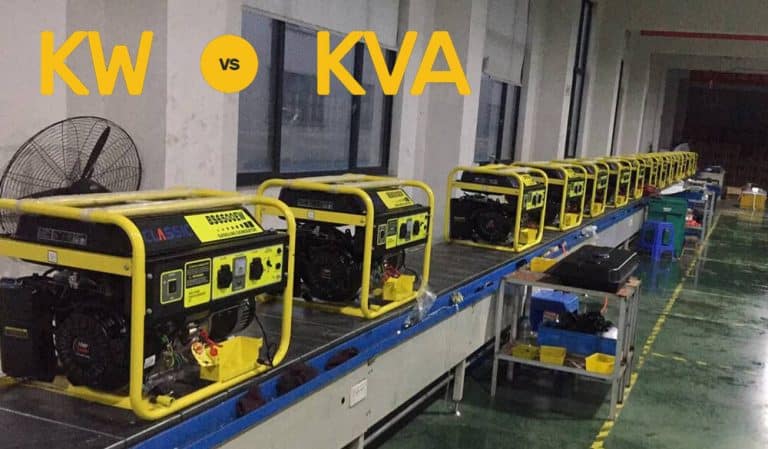what is the difference between KW and KVA?
- By BISON
Table of Contents
Outside the generator industry, the term kilovolt-ampere (kVA) is often confused. We’ve all heard of kilowatts (kW): what we learned in school, the ratings of appliances in our homes, and the unit of electricity we use.
They represent two different but interrelated aspects of power that keep our modern world running smoothly. What do these terms really mean? What is the difference between kW and kVA? Why should you care?
In this article, we’ll take a closer look at KW (kilowatts) and KVA (kilovolt amperes), clarifying their definitions, differences, and their profound impact on how we use and understand electricity.

What is kw (Kilowatts)
Kilowatt, denoted by kW, is a unit of power in the International System of Units (SI). Power is the rate at which work is done or energy is transferred. In electrical terms, 1 kW is equal to 1,000 watts and represents the amount of power that’s actually used in an electrical system or by an appliance to produce useful work.
In an electrical circuit, kW is calculated as the product of voltage (in volts), current (in amperes), and the cosine of the phase angle difference (also known as power factor) between them. The resulting figure represents the “real” or “active” power, which is the power that does the actual work of creating heat, light, motion, etc.
What is kVA?
Kilovolt-ampere, represented as kVA, is also a unit of power. However, unlike kW, kVA represents the “apparent” power in an electrical system. The higher the kVA power rating, the greater the generator’s capacity. The term “Kilovolt-Ampere” (kVA) describes this measurement. The lowercase letter “k” stands for kilo, which means thousand. The abbreviation kVA is often used in place of kilovolt-amps.
Apparent power represents the total power in an electrical system, both the power that does useful work (real power measured in kW) and the power that is stored and released by reactive elements in the circuit like capacitors and inductors. This stored and released power doesn’t perform any real work but is essential for the functioning of AC circuits.
So, if you want to know how many watts your generator can produce at any given time. You can calculate your kilovolt-amperes using this simple equation:
kVA = volts x amps x power factor / 1,000
For example, If you have a 120V/240V system that draws 25 amps per phase and has a PF of 0.8 (default), your total KVAR would be 25A x 240A x 0.8 / 1,000 = 25kVAR or 30 kW
kVA power ratings are important when selecting generators or motors for use in industrial settings. For example, if you need a motor to help drive a conveyor belt in your factory, you’ll want to ensure the motor has enough power so it doesn’t overheat and stop working.
what is power factor
Power factor is a measure of how effectively electrical power is being used in a system. It’s calculated as the ratio of real (or active) power, measured in kilowatts (kW), to apparent power, measured in kilovolt-amperes (kVA).
In simpler terms, power factor indicates the degree of alignment between voltage and current waveforms in an electrical circuit. A power factor of 1 (or 100%) signifies that voltage and current are perfectly in phase, meaning all the power supplied by the source is doing useful work. However, in many practical scenarios, the power factor is less than 1 due to the presence of reactive components like inductors or capacitors which cause a phase shift between voltage and current.
So, if you have a low power factor, it means a larger portion of the total power (kVA) isn’t being effectively used to do useful work (kW). This leads to inefficiencies and higher electricity costs, as the system needs more total power (higher kVA) to perform the same amount of work (same kW).
What is the difference between KW and KVA?
The main difference between kVA and kW in the context of generators is how they represent power.
kVA, or kilovolt-ampere, is the unit used to measure apparent power. It considers the magnitude and phase angle of the current and voltage in an AC (alternating current) circuit. Apparent power represents the total power consumed by a device or system, including valuable or real and reactive power.
A kW, or kilowatt, on the other hand, is a unit that measures actual power. Real power performs valuable functions, such as powering electrical appliances or equipment. It does not consider any reaction force.
In simple terms, while kVA indicates the generator’s total capacity, kW represents the actual usable power output available to operate the electrical equipment or appliances.
By understanding these distinctions, businesses can make informed decisions when purchasing generators for their needs. BISON Industry, as a leading company, offers expert guidance and reliable generator solutions to suit various business needs.
Applications of kW and kVA
Kilowatts (kW) are widely used to represent the power ratings of electrical load devices. This includes a broad spectrum of applications:
- Electric motors: From industrial machinery to household appliances, electric motors’ power capacities are often rated in kW. This gives an indication of how much power the motor will consume when running at its optimum efficiency.
- Electric heaters: The effectiveness of an electric heater in producing heat is quantified in kW. A higher kW rating signifies a more powerful heater capable of warming larger spaces.
- Lighting: The power consumption of light bulbs and other lighting fixtures is also measured in kW. This helps in determining the energy efficiency of various lighting solutions.
Kilovolt-amperes (kVA), on the other hand, are primarily used in contexts where the total power in a system needs to be considered. It’s extensively applied in the following areas:
- Power distribution: Power companies use kVA to measure the total power supplied to homes and businesses. This allows them to ensure they have sufficient capacity to meet demand and plan for future infrastructure upgrades.
- Generators: Generator capacities are often rated in kVA. This indicates the maximum amount of apparent power that the generator can supply, helping users choose a generator that matches their power requirements.
- Transformers: The capacity of transformers, which are crucial in power transmission and distribution, is also specified in kVA. This helps in the selection of suitable transformers for specific applications.
In summary
kW (Kilowatts) and kVA (Kilovolt-amperes) are two fundamental units of power measurement in electrical engineering. Understanding the distinction between kW and kVA, as well as their applications, is key to optimizing power usage and selecting suitable equipment for various power needs.
This knowledge is essential to optimizing electrical systems, ensuring efficiency, and preventing equipment overload or underutilization. By understanding the important relationship between KW and KVA, you can make informed decisions about their energy needs, ultimately leading to more cost-effective and reliable electrical solutions.
FAQs about kw and kva
What is the importance of kVA and kW ratings in choosing a generator?
kVA ratings help determine a generator’s total capacity and size requirements, taking into account both real and reactive power. However, the kW rating indicates the power output for operating electrical equipment. Both classifications are essential in selecting the right generator to meet specific power demands.
Can kVA and kW values be equal in a generator?
Yes, the kVA and kW values may be equal in some cases. This occurs when the electrical load is purely resistive, with no reactive components. In such situations, the power factor is 1.0, which aligns the kVA and kW values.
How do you convert kVA to kW?
To convert kVA to kW, multiply the kVA value by the power factor (PF). The power factor represents the ratio of real power (kW) to apparent capacity (kVA) in an electrical system. The formula to convert kVA to kW is kW = kVA × PF.
Is 1kw equal to 1kva?
kVA is a measure of apparent-power: it tells you the total power used in the system. kW = kVA in a 100% efficient system. However, electrical systems are never 100% efficient, so not all of the system’s apparent power is used to produce valuable work.
.png)
-qbpqbzxxvtguiuwezisu6wo6j1i29b4m1el1ir1u8o.png)

